Spectroscopy Uncensored: An Insider's Story of the First 15 Years
Former Editor-in-Chief Michael MacRae reviews the early history of Spectroscopy in the context of the times and according to the author's personal perspective.

In 1985, at the dawn of a period of major transition in both the science and industry of spectroscopic instrumentation, Spectroscopy magazine was launched in the hope of serving the diverse cross-section of scientists with specialist expertise in this dynamic field.
I had the honor of serving that community from the very beginning until 2002. I wore many hats during that time: product writer, copy editor, editor-in-chief, editorial director, and even a mercifully brief stint as ad salesman. I also took the Spectroscopy hat off entirely a few times to try my hand at other projects, but more often than not found myself back in the fold.
When first invited to share my perspectives on the early days of Spectroscopy magazine, I was unsure. I have been associated with the magazine and this field for well over half my life, and have more than one article's worth of war stories as a result. The trouble is, they are interesting only to me. The idea of devoting several precious pages of Spectroscopy's 25th anniversary issue to my own exploits goes against everything I stand for as an editor. So naturally, I jumped at the chance. It hit me just how long a span 25 years is, and how extraordinary an achievement it is for a publication like Spectroscopy to have endured for so long in the service of such a complex field.
The recent losses of spectroscopic legends like Paul Wilks and William Fateley were further reminders that time is indeed marching on. Over the course of a generation, many of the people the magazine was established to serve have left the field. Moreover, a substantial number of today's Spectroscopy readers were not even born when it made its debut. For newer readers, this article may provide some useful context about the publication and what we set out to do 25 years ago. For veterans, let it serve as a mostly lighthearted look back at the people and trends that shaped an eventful period in our shared history.
Prehistory
To understand how there came to be a Spectroscopy, let's take a look at the business of scientific periodical publishing in the 1970s and early 1980s.
The field consisted of the traditional scholarly journals serving the high-end academic and research community, and mass-circulation "trade" publications providing product news and varying degrees of scientific information.
There was no shortage of either style of publication, but a significant gap existed between them.
Academic journals remain vital to the advancement of science. However, journals that sit on library shelves or are circulated only among closeknit groups of dues-paying members do not always create the opportunity for immediacy, reader engagement, or the cross-pollination of ideas that stimulate a community and make it thrive. Conversely, the trade magazines of the era, despite their attractive subscription prices (free) and broad reach, often fell short in terms of the depth of their scientific content.
A new publication was launched in 1977 that aimed to fill that gap, reaching the broadest possible audience of interested readers with high-quality, highly relevant scientific and technical information. That magazine, Pharmaceutical Technology, was produced out of Los Angeles (and later, Eugene, Oregon) by a maverick publisher named Ed Aster. It integrated the divergent worlds of scholarly and trade publishing in a format that has in no small way redefined the business of scientific niche communication.
Pharmaceutical Technology may have been the first post-modern scientific periodical. It combined the best elements of all existent print media serving scientific clientele of the era. Its technical content was peer reviewed by a distinguished editorial advisory board and presented in a format befitting a classical scholarly journal. At the same time, its coverage of products and industry services was voluminous and, importantly, edited with objectivity and attention to editorial detail: no recycled advertiser press releases here. And anyone who could possibly be interested in its esoteric content could get it for free. What's not to like?
The late 1970s saw an exploding demand in the pharmaceutical industry for the emerging technique of high performance liquid chromatography (HPLC). HPLC revitalized separation science and greatly expanded the demand for published information about the new technique. Consequently, Pharmaceutical Technology enjoyed a surge of new advertising from HPLC vendors. The need for a new, focused publication was obvious. Aster was in the right place at the right time to get it done. Enter LC Magazine (now known as LCGC), which did for chromatographers what Pharmaceutical Technology did for technical personnel in the drug industry.
LC Magazine brought an unprecedented depth of coverage to the chromatography community, offering up the same mix of applied science, tabloid-style product information, and most importantly of all, a much-needed sense of community to this rapidly changing field. With an editorial advisory board comprising many of the very founders of the field, LC Magazine quickly proved that the business model of a well-focused controlled-circulation periodical could work for a relatively small niche within the larger scientific market, and the necessary ingredient of this success was an editorial product that spoke to highly educated readers in a voice and format they could take seriously, and even respect.
Spectroscopy is Born
Based upon the success of LC Magazine, the next logical development would be a title focused on some other segment of the analytical sciences. The idea of a magazine focused on spectroscopic instrumentation seemed like a natural. There were important differences, however, that have made Spectroscopy's evolution quite different from that of its big sister.
For starters, to a greater extent than the HPLC community, the spectroscopy field was already buried in journals covering every conceivable niche. Some were highly revered, especially society-affiliated publications produced by the Society for Applied Spectroscopy, the Royal Society of Chemistry, and the American Chemical Society. Commercial publishers such as Elsevier, Pergamon Press, John Wiley & Sons, and Academic Press contributed to a proliferation of journals in and around the spectroscopy field, attracted by the healthy profit margins attainable by inflating the subscription rates charged to their most reliable customers, the libraries.

Figure 1
Rather than duplicate worthwhile existing efforts, we designed Spectroscopy as an applications-oriented complement to the primary literature, as a more focused, scientifically rigorous alternative to the existing laboratory freebies. If spectroscopists had more than enough publications they had to read in a library, we would give them one they could read in the lunchroom.
There would probably not be a Spectroscopy without the enthusiasm and optimism of the woman who would become our first editor, Heather Williamson Lafferty (Figure 1). Heather was a bright and exuberant former Ph.D. student in chemical physics who had left grad school to join the editorial team of LC Magazine as its technical editor. With a diverse laboratory background in a wide range of analytical techniques, world-class spectroscopy contacts, a head full of ideas, and just the right mix of bravado and book-learning, Heather was a born editor-in-chief. With her vision and the guidance of a handful of charter advisors, Aster decided it could make a go of Spectroscopy. And so it did. With great fanfare, the oddly numbered Volume 1, issue 0, debuted at the fall 1985 Eastern Analytical Symposium in Atlantic City, New Jersey. Barring any disasters, monthly publication would commence the following January.
Heather's original editorial format has not fundamentally changed in a generation. The first issue featured dedicated columns of special interest to atomic and molecular spectroscopists; a couple of broad state-of-the-art overviews of emerging techniques, and a slate of application articles and technical notes that covered all the bases from atomic absorption (AA) to X-ray photoelectron spectroscopy (XPS). It took every ounce of Heather's ample persuasive powers, but somehow we found enough willing authors to commit their work to our fledgling journal sight unseen. Sadly, Heather died in 1998, but I know she always deeply appreciated that leap of faith.
One of the key differentiators between Spectroscopy and its rival trades is the practice of peer review for all technical articles. This process was absolutely essential to the editors' ability, as laypersons, to sleep at night knowing there were a few pairs of expert eyes looking at every manuscript.
Keeping Pace with Change
In 1985, microprocessors and personal computers were redefining how spectroscopy was done, who did it, how long it took, and what could be done with the instrumental data. Advances in optics and electronics enabled instruments to shrink while generating unprecedented levels of information. Spectrometers were moving to where the samples were: the process line, the Superfund site, the local paint store, and even the surface of Mars.
In atomic spectroscopy, the mid-1980s era of change led to an explosion of interest in plasma-source spectrochemistry, in the use of the graphite furnace in atomic absorption, and in the application of glow discharges in both emission and mass spectrometry (MS). MS detection paired with inductively coupled plasma (ICP) emission was transitioning from infancy to adolescence, but its commercial surge was many years in the future. Sample preparation using microwave digestion was dramatically improving productivity in elemental analysis labs.
In molecular spectroscopy, important new measurement and sampling techniques were enhancing instrument performance. For example, researchers at IBM and DuPont were applying some of the same principles used in the well-established FT-IR technique to overcome the problem of unwanted fluorescence effects in Raman spectroscopy. FT-Raman revived interest in, and extended the capabilities of, this once esoteric technique, creating a new commercial market in the process. Meanwhile, advances in dispersive Raman and Raman microspectroscopy fueled an all-out Raman renaissance.
Probably no sector of the spectroscopy community has undergone such a profound transformation as MS has during the past 15–20 years. Computation and ongoing overall refinement of the instrumentation have put mass measurements within the reach of many more laboratories while propelling the technique to the forefront of today's burgeoning biomedical applications in genomics, proteomics, and related life science fields.
Spectroscopy worked hard to stay ahead of each of these trends, emphasizing the value of sharing these emerging developments with the broad spectroscopy community.
One memorable example was a 1986 paper by IBM's John Rabolt and coworkers describing the potential of FT-Raman spectroscopy in industrial applications early on in the technique's development. Its timing was perfect, and it became one of the most highly cited articles we've ever run. Advisor John Coates' monthly "Molecular Spectroscopy Workbench" column kept readers up to date on key topics such as computer hardware, software and data-exchange strategies, IR sampling methods, spectral interpretation, instrument design, and industrial applications. Our long collaboration with mass spectrometrist Ken Busch is worth a special note, as his "Mass Spectrometry Forum" column has been critical to our coverage of this sector of the community.
Spectroscopy's predominantly industrial audience was a natural fit for the novel technologies championed by the hotbeds of process analytical chemistry innovation at the University of Washington and University of Tennessee. Specifically, Spectroscopy has been a regular home for authors working to document the effectiveness of near-infrared analysis, remote sampling, chemometrics, and other real-world spectroscopic solutions. Howard Mark and Jerry Workman began a highly popular regular tutorial feature, "Statistics in Spectroscopy," very early in the magazine's history and are still at it today, with the "Chemometrics in Spectroscopy" series. Their work for Spectroscopy has been the basis of two well-received books.
Of course, Spectroscopy was by no means the only publication covering these topics. Our special contribution was the size and coherence of our audience, and the depth, authority, and timeliness of the material we published. The formula has been a driver of progress in the community.
London Calling
The first three or four years of Spectroscopy's existence were marked by transition. Founding editor Heather Lafferty left in 1987, initially to resume a career as an applications scientist for an FT-IR vendor and later to become the senior editor of Laser Focus World magazine. Her successor, B. Jane Ellis (Figure 2), established great relationships with exceptional authors and spearheaded many innovations during her tenure as editor, but she also soon moved on to explore new directions in scientific publishing with Academic Press. That left only me from the original team, and at age 26, with more than a little trepidation, I stepped into the editor's slot.
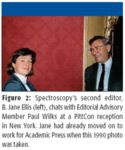
Figure 2
I was not afforded the luxury of time to worry about my new job. Almost immediately upon my appointment, I was put on a plane to London, where I was to reveal to unsuspecting attendees of the British Laboratory Week tradeshow that the Yanks were coming.
Aster Publishing had recently opened a European outpost in northern England with a flagship publication serving the medical device community. Its second entry into the European market — Spectroscopy International — was facilitated by the purchase of John Wiley & Sons' venerable European Spectroscopy News.
My assignment was to retool the popular ESN format into something more closely resembling our U.S. publication. It was decided that some of ESN's lighter features — such as "Philately Corner" — would go, in favor of what we considered to be technically meatier material from a pan-European audience. Spectroscopy International added elements such as an editorial advisory board and peer review of articles. One essential feature that we retained was Jenny Grasselli's wonderful "Letter from America" column, in which she or one of her notable guest authors would share unique views on the people, places, and events driving the U.S. spectroscopy scene. Jenny's participation certainly warmed our welcome on the Continent.
Although Spectroscopy International is no more, many of the editorial relationships we forged in Europe have remained strong. The experience introduced a new community of outstanding contributors to our pages while providing the basis for other overseas exploits in the spectroscopy field, including scientific conferences and online communication tools.
Brushes with Fame
In my day, Spectroscopy never sought, nor really wanted, to compete for the type of research papers published in the primary literature. Big-name authors, on the other hand, were a different matter. I and my predecessors spent many hours, and even more expense-account dollars, trying to form productive relationships with the gurus of the field, in hopes they would see fit to join our editorial board, contribute an overview or opinion piece, or guest-write one of our regular columns. Occasionally, it worked.

Figure 3
During my tenure, we were proud to have published at least two papers submitted by Nobel-caliber groups. Eleven years before winning the 1999 Nobel Prize for Chemistry, Ahmed Zewail (Figure 3), holder of the Linus Pauling Chair at California Institute of Technology, sent us a paper describing his work on ultrafast laser spectroscopy of chemical reactions. Richard Smalley and Harry Kroto's 1996 Nobel Prize-winning discovery of C60 (buckminsterfullerene), was based in great part upon the work of their graduate student Jim Heath, whose tinkering with toothpicks and Gummy Bears first revealed the characteristic soccer ball shape of buckeyballs (Figure 4). Heath's 1990 feature in Spectroscopy, "The Physics and Chemistry of Carbon Clusters," gave readers a preview of exciting things to come in the new field of nanotechnology.
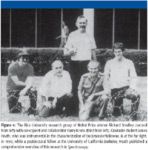
Figure 4
Of course, not everybody said "yes" to our enthusiastic invitations to contribute. Some of my favorite potential authors are ones who declined, but did so memorably. The classiest rejection I've ever received came from presumably one of the most famous scientists on the planet at that time: Carl Sagan (Figure 5). Mind you, I knew that Dr. Sagan was not primarily a spectroscopist, and I had no real expectation that he would take the time to write for us, but some of his publications circa 1990 involved interesting uses of spectroscopic data in space research. I thought it would be fun to get his quick take on current spectroscopy trends in cosmology. What came back in the mail was a charming, hand-signed kiss-off letter that made me feel like a million — or more appropriately, "billions and billions" of — bucks.
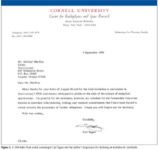
Figure 5
Change is Constant
Spectroscopy has had approximately 10 different editors at the helm during its 25-year run. Having had the job three times, I believe I brought valuable new insights to the position each time I returned. While I was gone, the magazine benefited greatly from the fresh approaches and new relationships formed by new editors. In addition to the aforementioned Heather Lafferty and Jane Ellis, I'm sure many readers will recall the names of our other editor-in-chief alumni: Linda Crabtree (Figure 6), Sarah Evans (Spectroscopy International), Karen Tartar, Sherrie Steward, Michelle Nicholson, and of course, today's leader, David Walsh. Each has made important contributions and refinements.
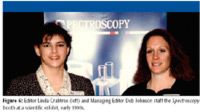
Figure 6
Change has also affected the publication behind the scenes. The feisty entrepreneurial spirit of Aster Publishing attracted the attention of Advanstar Communications, a large publishing and tradeshow firm with products serving more than 100 markets ranging from primary care medicine to propane and propane accessories. Advanstar and Aster merged, and Spectroscopy and its scientific sister publications have readily acclimated to life in this larger family. One significant change resulting from the merger was the relocation of the editorial enterprise from its exotic headquarters in Eugene, Oregon, to its current offices in Iselin, New Jersey. Although the West Coast location was always a point of distinction for the editors, there are significant advantages of living within the same time zone as most of your readers. Today, only Technical Editor Steve Brown remains based in Oregon (Figure 7).

Figure 7
In the publishing world, the biggest looming change, and the largest area of uncertainty, is of course the future impact of digital media on the ways we communicate. Spectroscopy is already active in scores of creative activities that offer new levels of engagement to readers: social media sites, webcasts, e-newsletters, and other electronic services. As someone whose first editor's toolkit at Spectroscopy involved an electric typewriter, piles of correction tape, and a few colored pens, I find this all somewhat daunting. However, it presents you, the reader, with unprecedented opportunities to learn, share, and grow in the field. The strong relationships Spectroscopy has formed with its readers and contributors will only become stronger through these new opportunities to interact.
Conclusion
After a generation, Spectroscopy continues to occupy a unique and, I would argue, important niche in the scientific literature. The story of its early years matters because the publication has been almost entirely shaped by the people who contributed to it. Its early editors intentionally, and perhaps, occasionally, to a fault, allowed this community to speak for itself in its own voice.
Working in fields ranging from astronomy to zeolite mining, Spectroscopy's readership includes its share of elites, enthusiasts, eggheads, egoists, and extraordinary talents, all with something potentially interesting to bring to the conversation. Spectroscopy is the host and emcee of that discussion.
Spectroscopy has, as was promised in the first issue, served as their magazine, your magazine. By allowing a place at the table for the potent personalities behind the amazing science of spectroscopy, our magazine has held a powerful mirror up to this community, reflecting in full measure its colorful spectrum of people, perspectives, and ideas. In the digital age, it has more than ever to offer those in the spectroscopy community who take advantage of it.
Acknowledgments
The author acknowledges the vital contributions of John Coates, Mark Tatro, Emil Ciurczak, Howard Mark, Jerome Workman, Jr., David Ball, Ken Busch, Don Kuehl, Paul Bourassa, Jenny Grasselli-Brown, Bob McDowall, Nancy Miller-Ihli, Conrad Gregoire, Eileen Skelly-Frame, and the many other regular contributors and advisors who have, with both frequency and intensity, given their time, talents, and expertise to this effort.
Michael MacRae is the Communications Manager at the Oregon Health & Science University Foundation, Portland, Oregon. He is the former editor of Spectroscopy, LCGC, and Pharmaceutical Technology and former group editorial director of the Advanstar Science Group. He was employed by John Wiley & Sons from 1991 to 1993.
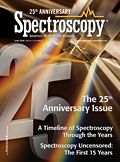
Best of the Week: AI and IoT for Pollution Monitoring, High Speed Laser MS
April 25th 2025Top articles published this week include a preview of our upcoming content series for National Space Day, a news story about air quality monitoring, and an announcement from Metrohm about their new Midwest office.
LIBS Illuminates the Hidden Health Risks of Indoor Welding and Soldering
April 23rd 2025A new dual-spectroscopy approach reveals real-time pollution threats in indoor workspaces. Chinese researchers have pioneered the use of laser-induced breakdown spectroscopy (LIBS) and aerosol mass spectrometry to uncover and monitor harmful heavy metal and dust emissions from soldering and welding in real-time. These complementary tools offer a fast, accurate means to evaluate air quality threats in industrial and indoor environments—where people spend most of their time.